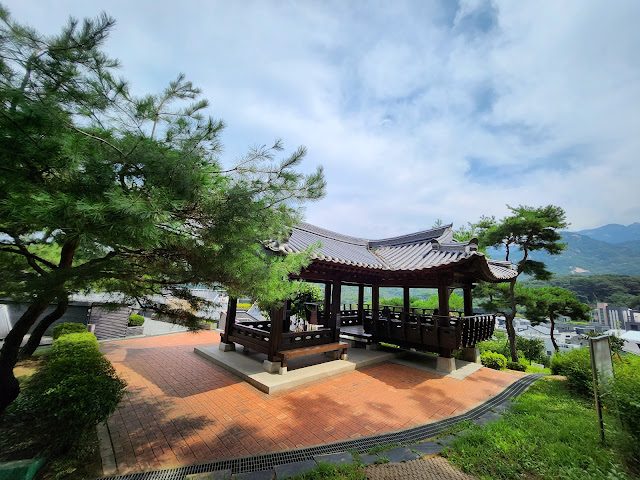Ganghwado Island, off the west coast, is
the fifth largest island in Korea located 1 hour from Seoul.
It has very rich heritages such as lots of
dolmens (UNESCO World Cultural Heritage) that are amazing prehistoric remains, fortresses
that were used to protect Korea, Peace Observatory to see the North Korean coastline and people from around 1.8km, gorgeous old temples, beach, and so on.
Actually, it is famous for the Chamseongdan Altar on top of Mt. Manisan where Dangun
Wanggeom, the first Korean Kingdom offered sacrificial rites to the heavens.
This island has many famous local products,
including the medicinally effective Ganghwa ginseng and Hwamunseok, a sedge mat
woven with various patterns.
The Tripitaka Koreana, 81,258 wooden
printing blocks (UNESCO memory of the world) in 13 century was made on this
island for praying to protect from Mongolian invasion. At that time Koryeo
dynasty moved from Gaeseong, the capital, to this island to fight against the
Mongolian troops. Tourists can visit the palace site of Goryeo from 1232 to 1270.
1. Palace Site of Goryeo Dynasty
The palace of Goryeo was built in the 13 century as King moved his capital to Ganghwado Island with the advantage of natural and strategical points of view against Mongolian invasion. Upon the withdrawal of Mongolian forces after vigorous resistance for 39 years, the capital was moved back to Gaeseong after the peace treaty with the Mongols concluded and then the palace was subsequently destroyed.
In Joseon dynasty, the consolidated palace including many subsidiaries such as Waegyujanggak national library, Haenggung king's family's residence and etc. were built on the very site of the previously existing Goryeo palace. These buildings were burnt down by the French navy during Byeongin yangyo conflict in 1866.
2. Gangwha Peace Observatory
Ganghwa Peace Observatory is located on the north of the island It provides
historical information about the Korean War (1950-1953).
When
driving to the Ganghwa Peace observatory, visitors need to pass through a military gate, feeling that they enter a
military zone.
It offers the chance to see a beautiful natural environment and the
coastline of North Korea. It is very
impressive to see how close is North Korea away just 1.8km. It may provide a special experience whenever visitors see people living on the other side of the
border completely through a telescope.
3. Hwamunseok Cultural Center
Hwamunseok is the legacy of our cultural life as it is inherited from Goryeo (10c~14c) period, being the product that is exclusively produced in this island Ganghwa-gun.
In this Center, the visitor can appreciate various handicrafts as well as beautiful Hwamunseok made with sedges. In addition, the visitors can have an opportunity to make a rush-made product and Hwamunseok under the guidance of a handicraftsman.
.JPG)
4. Dolmen Hwamunseok Cultural Center
There are more than 30,000 dolmens in South Korea, nearly 40%
of the world dolmens.
Dolmen are stone
tombs dating from prehistoric times in Korea. In Ganghwado remains some of the
main dolmens and they were designated as the UNESCO World Cultural Heritage along with the dolmens in Gochang and Hwasun.
5. Jeondeungsa Temple
Jeondeungsa Temple is located in Samnangseong Fortress and was first constructed in 372.
Jeondeungsa Temple contains significant architectural works, including the main building Daeungbojeon Hall (a Treasure), built in 1621. Visitors can see the names of soldiers written on the walls and columns of Daeungbojeon Hall. These soldiers fought against the French Navy in 1866.
6. Dongmak Beach
Dongmak Beach is a pristine attraction with white sands surrounded by a forest of pine trees. During high tide, visitors can enjoy sunbathing, while during low tide, a large mud flat opens up for visitors to observe various sea life such as clams, crabs, and more. There are many attractions nearby to see and enjoy.
7. Others
(a) Minmeoru Beach
Minmeoru beach is a sandy beach with a beautiful atmosphere. Tourists can catch shells, relax on this beach, and spend a beautiful day.
(B) Bomunsa Temple
Bomunsa Temple is located on Seongmodo Island connected with Ganghwado Island. It is believed to have been founded in 635. The temple faces out to the ocean, with the sound of waves reaching all the way to the main building. .JPG)
.JPG)
.jpg)
(C) Gyodongdo Island
Gyodongdo Island is located northwest of Ganghwado Island and is accessible with a bridge. Popular attractions on the island now include Daeryong Market, an alleyway market decorated with colorful murals and statues, and Manghyangdae Memorial, a gathering place for refugees who fled from the nearby Hwanghaedo Island during the Korean War.

.jpg)
.jpg)
.jpg)
.jpg)
.jpg)
.jpg)
.jpg)
.jpg)
.jpg)



























.JPG)
.JPG)
.JPG)
.JPG)
.JPG)
.JPG)
.JPG)
.JPG)
.jpg)
.JPG)
.JPG)

.jpg)
.JPG)
.jpg)
.jpg)

.jpg)

.jpg)
.jpg)
.jpg)
.jpg)
.jpg)
